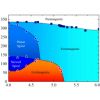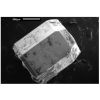Intermetallic Compounds and Hybrid Materials group

Magnetic phase diagram (x, T) of the YbMn6Ge6-xSnx system for 4 ≤ x ≤ 6 and T ≤ 350 K

Scanning electron microscopy image of a single hexagonal crystal of YbMn6Ge2Sn4
Diffraction shot of a single crystal of K2FeII(C2O4).2H2O
Last publications
- Conical incommensurate magnetic ordering in the transition metal-rich YCo12B6 ternary boride
B. Vallet-Simond, O. Isnard, L.V.B. Diop
Journal of Alloys and Compounds, 2025, 1037, pp.182379. ⟨10.1016/j.jallcom.2025.182379⟩ - High-resolution and high-pressure x-ray diffraction study of ScFe2Hx compounds
S. El Bidaoui, L.V.B. Diop, V. Svitlyk, C. Hennig, O. Isnard
Materials Today Communications, 2025, 46, pp.112542. ⟨10.1016/j.mtcomm.2025.112542⟩ - A structural study and some magnetic properties of Hf1-xMoxFe2 Laves phase materials
I. Sarr, O. Isnard, A. Vernière, L.V.B. Diop
Journal of Alloys and Compounds, 2025, 1037, pp.182354. ⟨10.1016/j.jallcom.2025.182354⟩
Presentation
The intermetallic compounds and hybrid materials group studies the properties and crystallo-chemistry of two families of bulk solids: intermetallics and MOF-type (Metal-organic frameworks) hybrids.
The intermetallics studied by the group associate metallic elements with metalloids and can contain up to two magnetogenic elements (a metal from the 1st transition series and/or a lanthanide). They are the seat of physical phenomena that are interesting from the fundamental (quantum criticality, intermediate valence, frustrated magnetism, etc.) and applied (magnetocaloric materials, permanent magnets, sensors, etc.) points of view.
The work on hybrid materials concerns crystalline solids in which low-dimensional mineral entities (sheets, chains, etc.) are linked together by organic molecules with dicarboxylate groups. The MOFs studied by the group contain at least one magnetic cation (3d or 4f). Our research especially aims to develop multifunctional systems where the magnetic properties are in synergy with other physical properties such as, for example, systems with magneto-optical properties.
The two families of materials studied are very disparate from a crystallo-chemical point of view, and require various means of synthesis ranging from soft chemistry for hybrids to high-temperature metallurgy for intermetallics. However, they are studied using common and shared tools, in particular: X -ray and neutron diffraction, and Mössbauer spectrometry, along with magnetic measurements (AC and DC) and measurements of specific heat.
Currently the group is working on transversal topics to apply to these two families, including: Quantum criticality, Magnetocaloric effect, and Frustrated magnetism.
These materials are studied in collaboration with other teams from the laboratory: Surfaces and Spectroscopies; Materials with Themoelectric Properties and through national and international projects.
Part of the research is carried out using large instruments:
- Powder Neutron Diffraction in the Institut Laue Langevin
- Neutron Diffraction on a single crystal in the Paul Scherrer Institute
- XANES and XMCD under pressure and X-ray diffraction at the SOLEIL Synchrotron
Research Topics
Quantum criticality
When a second order phase transition is brought to absolute zero using a control parameter (external pressure, chemical composition, or magnetic field), the singular point separating the two fundamental states is called the quantum critical point.
Quantum criticality is studied in various families of materials including high-temperature superconductors, quantum magnets and heavy fermion systems. It can also occur in MOFs, especially under magnetic field conditions in systems with low-dimensional magnetic entities.
Beyond the fundamental interest of this research, quantum criticality is considered to underlie unconventional superconductivity. It could play a role in quantum information processing.
Project:
CNRS France/Taiwan project 2019-2022
Thesis:
Pauline HARAUX, 2018-2021 (Ministry doctoral contract)
Article:
Possible room-temperature signatures of unconventional 4f-electron quantum criticality in YbMn6Ge6−xSnx, Eichenberger et al., PRB Rapid Communications 2020, 101, 020408(R).
The Magnetocaloric Effet
The magnetocaloric effect corresponds to the variation in temperature or entropy of a solid subjected to a variable magnetic field.
This effect has been used for several decades for refrigeration at very low temperatures (< 1 K). Its use is expected to develop considerably in the near future, particularly due to the forthcoming expected helium shortage. It may concern standard paramagnetic systems, or materials with a quantum critical point in the vicinity of which the magnetocaloric effect is enhanced.
Over the last twenty years, major international research has focussed on trying to exploit this effect in near-ambient refrigeration applications. More recently, work has been initiated to take advantage of the magnetocaloric effect in applications operating at higher temperatures. These include heat pumps or the conversion of low-grade heat (fatal, geothermal, etc.) by a thermomagnetic effect.
Project:
CEA Tech 2015-2018
Article:
A Metal-Organic Framework as attractive cryogenic magnetorefrigerant, Sibille et al., Chem. Eur. J. 2012, 18, 12970.
Magnetic Frustration
Frustrated magnetism occurs in spin arrays with specific geometries that are often based on triangular patterns. It occurs when the system cannot simultaneously minimize all individual magnetic interaction energies. The competition between different magnetic interactions in the system can possibly stabilize rare fundamental states.
This is a topic that we have recently tackled on intermetallics, in collaboration with researchers at the Paul Scherrer Institute (Villigen, Switzerland) who are specialists in this field. We are developing this topic because some of the intermetallic families that have been studied by the group for several decades contain atomic arrangements that are conducive to frustration (Kagomé plans). This topic can be extended to MOFs.
Project:
PHC Germaine de Staël France/ Switzerland 2017-2018
Know-how
Development
High-temperature preparation of poly- or single-crystal inorganic materials:
- Preparatory work in a glove box
- Annealed in controlled atmosphere vials
- Induction furnace
- Arc furnace
- Flow Methods
Soft chemistry synthesis of MOFs:
- Hydro/solvo-thermal methods
- Device combining peristaltic pumps and a wet anaerobic chamber
Characterization
- Diffusion experiments on laboratory machines (powder or single crystal X-ray diffraction, in collaboration with the X-Gamma competence centre)
- Experiments on large instruments (X-ray diffraction, neutron diffraction, XANES, XMCD)
- AC/DC magnetic measurements, measurements of specific heat and resistance (PPMS, VSM) in collaboration with the magnetism and cryogenics competence centre
- Mössbauer Spectroscopy in collaboration with the X-Gamma competence centre
- Experiments under high pressure (XANES, XMCD, neutron diffraction)
Members
CNRS researchers
- Léopold DIOP
- Yvan SIDIS
Professors, assistant professors
- Lucas EICHENBERGER
- Pierric LEMOINE
- Thomas MAZET
- Anne VERNIERE
Technical and support staff
- Thierry SCHWEITZER
PhD students
- Orianne BORDES
- Emma CHAUVEL
- Ibrahima SARR
Emeritus
- Bernard MALAMAN
Publications
Contact
Head of the group
Thomas MAZET
thomas.mazet@univ-lorraine.fr
+33 (0) 3 72 74 25 43
Nancy-Artem
Institut Jean Lamour
Campus Artem
2 allée André Guinier - BP 50840
54011 NANCY Cedex
